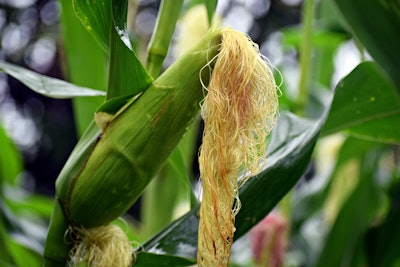
The December futures price of corn settled in a range of $3.20 – $3.25 over the last few trading sessions. Questions regarding a price bottom for corn bubbled up in market discussions. A yield-enhancing weather outlook and flattening ethanol production offset large export sales last week. A change in the recent corn price pattern involves a smaller corn crop than those formed by current market expectations.
Corn demand presented a mixed bag over the last few weeks. After a steady recovery in ethanol production, the last three weeks saw weekly production level out. Production levels averaged 932 thousand barrels a day over the period. While sharply higher than the 537 thousand barrels seen at the end of April, the production level sits 10.1 percent lower than over a similar period last year. Current USDA estimates of corn use for ethanol sit at 4.85 billion bushels for the marketing year. Through June, corn used in ethanol production totaled 4.02 billion bushels. Based on estimates of corn use using EIA weekly ethanol production, corn consumption for ethanol as of July 31 is approximately 4.43 billion bushels. The refinery-operating rate stalled at roughly 80 percent, yet gasoline stocks continue to grow. Gasoline demand remains weak despite being in the summer driving season. If ethanol production levels match totals seen in July over the next month, corn use for ethanol production comes in 10-15 million bushels below the USDA estimate. If ethanol production falls back due to lower gasoline demand, corn use for ethanol looks to fall further.
Export sales to China dominated the positive news for corn demand. Most of the large purchases are for the 2020-21 marketing year. Export sales for the next marketing year sit near 435 million bushels with China accounting for 225 million bushels of those sales. While a positive development, Chinese buying is rapidly approaching the 283 million bushel level set for their tariff rate quota (TRQ) on corn imports from a country. Purchases above the TRQ level see tariffs jump to 65 percent. It seems doubtful China looks to buy more U.S. corn under higher tariff levels given Chinese stocks supposedly sit near eight billion bushels. Flooding, armyworms, and uncertainty regarding corn stock quality in China all support recent purchases and could lead to an increase in the quota level. If all of those sales to China come to fruition next marketing year, the prospect of reaching USDA’s projection of 2.15 billion bushels in 2020-21 looks much brighter if a tad optimistic in the current economic environment.
USDA estimates corn exports for 2019-20 at 1.775 billion bushels this marketing year. Exports through June total 1.43 billion bushels, down over 22 percent from last year over the same period. Accumulated exports through August 6 came in at 1.64 billion bushels. With slightly over three weeks left in the marketing year, an additional 134 million bushels of exports are required to reach the current USDA estimate. Export inspections must average 37.6 million bushels per week. For the four weeks ended August 6, weekly export inspections averaged 38.3 million bushels per week. Outstanding sales for this marketing year through July 30 total 200 million bushels with China accounting for almost 50 million bushels. The recent pace of export inspections indicates exports remain on pace to come in close to the current estimate.
Excellent crop ratings kicked speculation on this year’s corn crop into high gear. A consensus formed around national yields ending up higher than USDA’s forecast of 178.5 bushels per acre. Supply considerations drove futures prices lower as the market priced in a large crop. The relationship between the seasonal average farm price and the stocks-to-use ratio provides insight into the question of market expectations of crop size. The closing futures prices for corn on August 7 indicated a marketing year farm price of $3.19 per bushel. For this analysis, a $3.19 average farm price relates to a stocks-to-use ratio of 21.3 percent for the 2020-21 marketing year. The estimated relationship between price and the stocks-to-use ratio uses data from the last ten marketing years.
The recent projection for corn use sits at 14.625 billion bushels. The possibility of corn consumption at the projected level remains quite uncertain given economic conditions. By assuming the projected USDA total use for the next marketing year, a stocks-to-use ratio of 21.3 percent infers ending stocks for the 2020-21 marketing year at 3.12 billion bushels. Using beginning stocks of 2.285 billion bushels and an import level of 25 million bushels during the next marketing year, the corn crop implied by the current market price equals 15.43 billion bushels.
Assuming the 2020 U.S. corn harvested acreage remains near the June acreage total of 84.1 million acres, a crop size of 15.43 billion bushels implies a corn yield of 183.5 bushels per acre. While a few recent yield projections came in near this total, the potential for a yield below this level seems likely. My current yield forecast for the U.S. sits at 180.7 bushels per acre. August weather looks to go a long way in determining the eventual size of the crop. A change in corn planted acreage remains in the picture as well.
The USDA takes their initial cut at the size of the 2020 corn crop in the August 12 crop production report. An increase from present projections of the corn crop seems in the offing. The magnitude of the change in corn production is the critical component for any scenario were corn prices find a bottom.
Hubbs, T. "Corn Bottoming or Taking a Breather?." farmdoc daily (10):146, Department of Agricultural and Consumer Economics, University of Illinois at Urbana-Champaign, August 10, 2020.

















